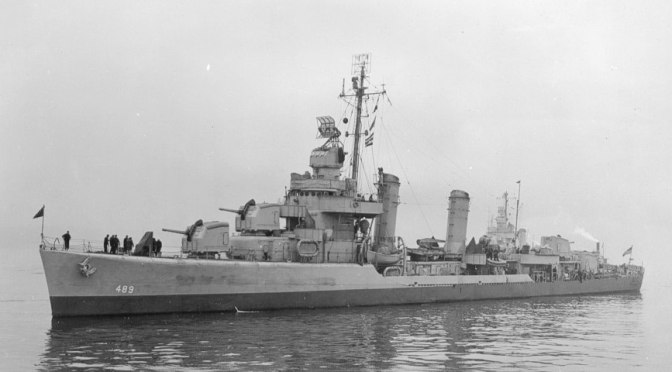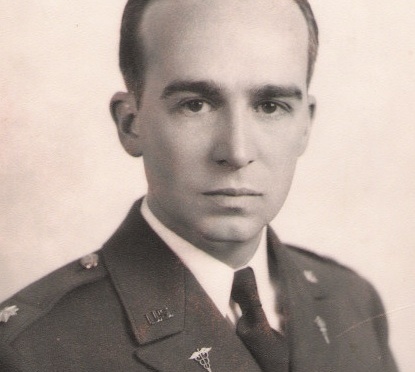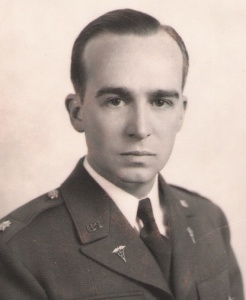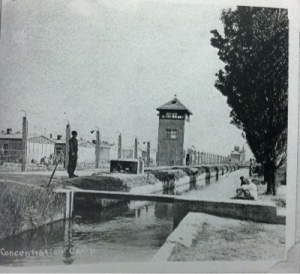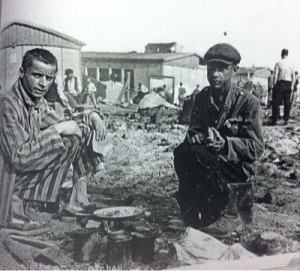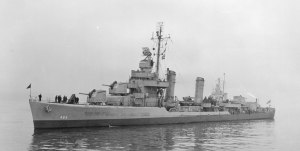 |
| USS Mervine (DD-489) off New York Navy Yard, 23 January 1943. Photo courtesy of the US National Archives. |
As Memorial Day approaches, I am honoring a World War II veteran who thankfully made it back home — my grandfather Michael John Flanagan (1927 – 1997). Grandpa claimed to have served on multiple Naval ships while in the war including one that sank. But Grandpa was a huge tall-taler (true to his Irish roots), so his children and grandchildren really never know what to believe.
One ship name that his children remembered Grandpa mentioning is the Mervine. The USS Mervine was a US Navy Destroyer originally launched on May 3, 1942 as DD-489, then reclassified on May 30, 1945 as DMS-31. She saw duty during the Second World War in North Africa, Mediterranean Europe, the North Atlantic, and the Pacific. Decommissioned on May 27, 1949, the Mervine was sold for scrap in 1969.
According to the US Navy Muster Rolls, Michael served on the USS Mervine from October 14, 1945 to February 20, 1948. He joined the crew of the Mervine 16 months into his Naval service (I have not yet identified where he was previously assigned). The Mervine arrived at Buckner Bay, Okinawa, on September 28, 1945, after being reclassified, and shortly after the September 2nd Japanese surrender. On October 16, 1945, Ship’s Cook 2nd Class Michael J. Flanagan and his shipmates sailed out of Buckner Bay.
 |
| Muster Roll listing dated October 16, 1945. Click image for a larger view. |
 |
| October 16, 1945 Muster Roll header. Click image for a larger view. |
The Mervine and its crew reported to San Francisco, California on March 31, 1946 (confirmed on the April 1, 1946 muster rolls), where she spent two years engaged in west coast operations.
Just shy of two months after arriving in San Francisco, Michael (now a Ship’s Cook 3rd Class) met his future wife Elsie Charlotte Hayes for the very first time on May 23, 1946, while out with a bunch of his shipmates on Michael’s 19th birthday. Mike and Elsie married less than one month later, on June 22, 1946. The marriage license shows Michael living at the Alameda Naval Station at the time of their wedding, however muster rolls show him still assigned to the Mervine. Michael served with the Mervine during the birth of his first child (muster rolls do show he was granted a leave of absence for her actual birth), and when their second child was conceived.
SC3 Michael J. Flangan transferred off of the USS Mervine on February 20, 1948, right before the Mervine returned to Pacific operations in Japan, China, and Pearl Harbor. I would assume this was so that he could remain closer to his young growing family.
Where he transferred to is the subject of another blog post.
Sources
Ancestry.com. U.S. World War II Navy Muster Rolls, 1938-1949 [database on-line]. Provo, UT, USA: Ancestry.com Operations Inc, 2011.
File:489mervine 01.jpg. (2005, December 17). Wikimedia Commons. Wiki. Retrieved May 19, 2013, from http://commons.wikimedia.org/wiki/File:489mervine_01.jpg
United States navy. (n.d.). Dictionary of American Naval Fighting Ships: Mervine. Naval History & Heritage Command. Webpage. Retrieved May 19, 2013, from http://www.history.navy.mil/danfs/m9/mervine-ii.htm
USS Mervine (DD-489). (2013, May 10). In Wikipedia. Retrieved from http://en.wikipedia.org/w/index.php?title=USS_Mervine_(DD-489)&oldid=544081252
